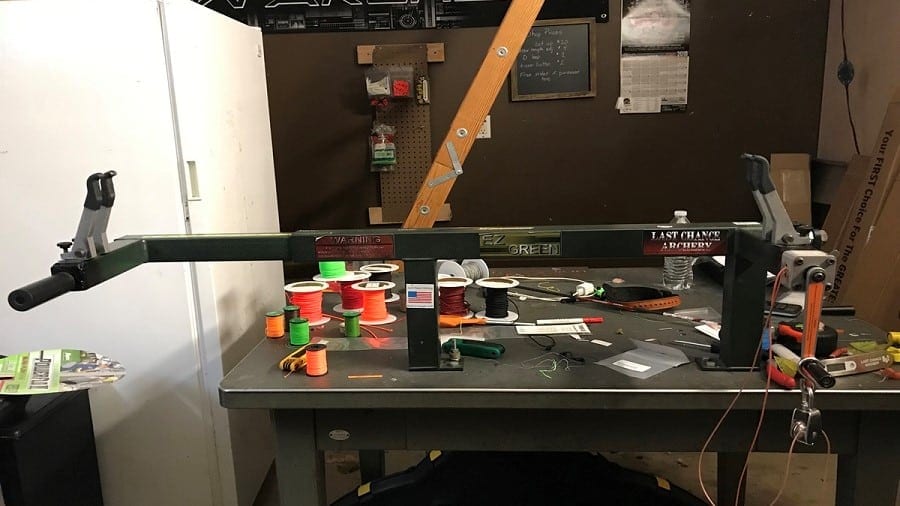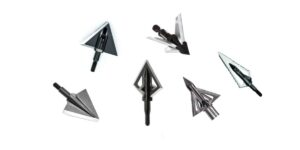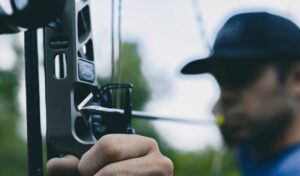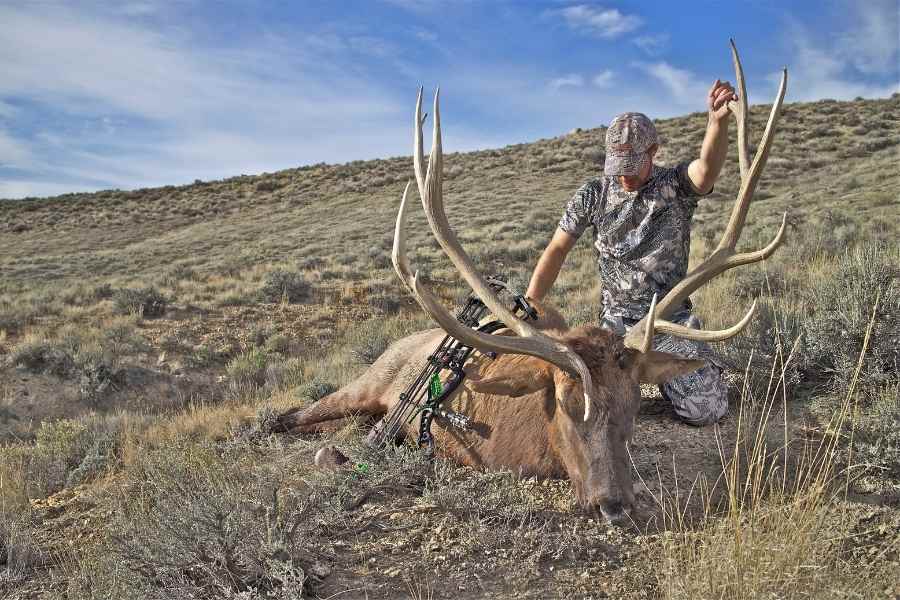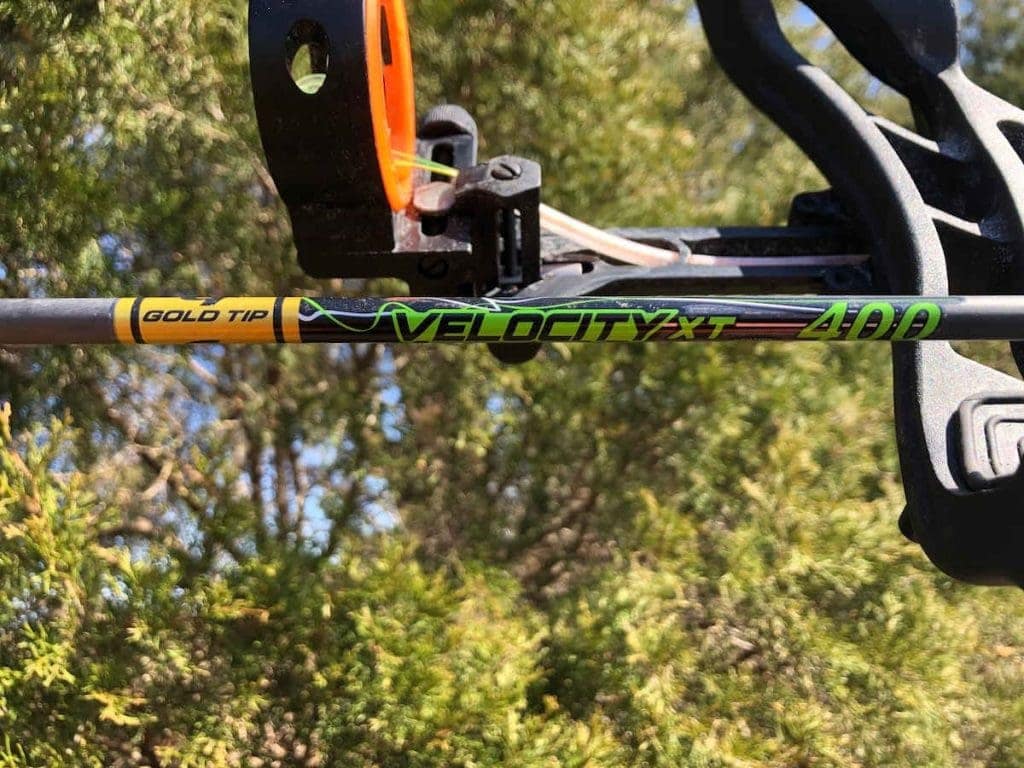When bowhunting, the difference between filling your tag or going home empty-handed often comes down to a few inches. When precision is key, most hunters strive to leave nothing to chance instead of doing their best to eliminate all possible variables.
This relentless pursuit of perfection has led many archers to purchase their own compound bow tuning equipment, thereby alleviating any reliance upon others to ensure their bow is operating at its full potential.
Contents (Jump to Topic)
ToggleThe following is a rundown of essential compound bow tuning tools every hunter should own, if he or she strives to maximize their bow’s accuracy, and be self-sufficient in their archery endeavors.
Essential Bow Tuning Tools
- Bow Press
- Allen Wrenches
- Grain Scale
- Bow Vise
- Bow Scale
- Serving Tool
- D-Loop Pliers
- Bow Square
- Arrow Prep Tools
- Chronograph
- Paper Tuner
Bow Press
If you are going to get hands-on with all matters of bow maintenance and tuning, you will quickly find that a bow press is an essential purchase.
A bow press allows you to situate your bow as desired, compress the bow’s limbs to relieve string tension and perform any manner of work that you desire.
read.. how much does it cost to restring a compound bow).
Using a bow press allows you to complete tasks that would otherwise be difficult or impossible without it.
Such tasks include adjusting cam timing, addressing cam lean issues, and installing string accessories such as peep sights and vibration dampeners.
Allen Wrenches
One of the simplest yet most valuable tools for all means of bow tuning and maintenance is a set of Allen wrenches.
These wrenches feature a hex-shaped head that fits the majority of fasteners found on modern compound bows.

Without a set of Allen wrenches, you will quickly find yourself unable to complete even the most basic tuning-related tasks.
read.. the best archery bow vise
Items such as sights, arrow rests, quiver mounts, and modular cams commonly feature Allen screws within their designs and mounting hardware.
It never hurts to have more than one set on hand.
Grain Scale
When attempting to tune your bow perfectly, arrow flight is everything.
To achieve precise arrow flight consistently, your arrows must be uniform in weight. In this case, simply guessing at your arrow’s weight will not be enough.
An accurate weight must be recorded for each arrow to identify inconsistencies. This is accomplished through the use of a grain scale.
A grain scale can measure and identify even the most minute of discrepancies in weight, thereby tipping you off to any accuracy-robbing discrepancies.
Bow Vise
When working on a bow, it is important to have both hands free to complete any necessary tasks in the most efficient manner possible.
Short of using a bow press when limbs are to be compressed, a bow vise will be your go-to tool.
Without the use of a bow vise, it can be nearly impossible to steady your bow in a way that allows for precise adjustments to be made.
A quality bow vise allows you to situate your bow in an upright position, where its cams, cables, accessories, and string can easily be accessed.
This eliminates the constant aggravation that comes with attempting to make adjustments in a freehanded fashion.
Bow Scale
While you might be able to get away without owning a bow scale, it is quite helpful to have one on hand.
A bow scale allows you to take the guesswork out of figuring draw weight.
This is important to know, as draw weight can affect everything from overall kinetic energy figures to the proper choice of arrow shafts.
A bow scale is very easy to use. Simply place the hook end of the scale through your bow’s D-Loop, draw your bow to peak draw weight, and record the highest draw weight that is observed.
Serving Tool
Servings protect high-wear segments of your bowstring, increasing its longevity and saving you time and effort in the long run.
However, servings themselves eventually wear and fray.
This is where the use of a serving tool comes in handy. A serving tool makes re-serving your bowstring an effortless task that can be completed quickly and efficiently.
Read more about the best bowstring serving tool here
Most serving tools come as a complete kit, typically including a string separator, cable spreader, serving tool, and thread.
This puts everything you need to re-serve your bowstring at arm’s reach.
D-Loop Pliers
Your bowstring’s D-Loop is yet another item that is prone to wear. Upon every shot, a certain amount of friction is produced between your release aid and D-Loop.
With time, the replacement of your D-Loop becomes necessary, and the use of a purpose-specific set of pliers can streamline this process.
Tying a D-Loop with a set of specialty pliers is as easy as lightly knotting each end of the loop, cutting off excessive string length, and cinching down the loop with the pliers themselves.
This process can be completed in a matter of minutes and also pre-stretches your D-Loop, eliminating any break-in period.
read.. untuned bows and arrow flight
Bow Square
Another item that is always handy to have at your disposal when performing any degree of bow tuning is a bow square.
A bow square can be attached to your bowstring, allowing you to take several helpful measurements.
It gives you exact figures to aid in tuning your bow to optimum performance.
One of the most significant advantages of compound archers using a bow square is the ability to set nocking points accurately and properly locate kisser buttons.
These functions come with their benefits, as both directly affect accuracy!
Arrow Prep Tools (Saw, Fletching Jig and Spin Tester)
The quality and consistency of your arrows play just as significant of a role in achieving notable compound bow accuracy as tuning the bow itself.
To get the most out of your arrows, just as much attention to detail must be applied when building a dozen arrows as when setting up your bow.
However, this attention to detail will be for nothing without the proper equipment to complete the job.
When building arrows, several tools are a necessity. You must first own a dedicated saw to cut your arrows to length. Next, you will need a fletching jig to glue and fletch your arrows.
Finally, having an arrow spin tester at your disposal is quite helpful. While not absolutely necessary, a spin tester will assist in discovering any shaft defects, such as out-of-round carbon shafts or bent aluminum shafts.
Chronograph
A chronograph is another piece of equipment that might not be considered an absolute necessity for tuning your bow.
However, it definitely comes with its fair share of advantages.
Perhaps the most significant advantage of chronograph use is the ability to judge whether or not any adjustments that you have made to your bow have increased its performance.
To use a chronograph, an archer shoots an arrow from their bow through the unit directly upon release.
The chronograph logs your arrow’s speed and provides instant feedback, allowing you to decide which direction to proceed with your tuning efforts.
Paper Tuner
Another item that is of immense value when tuning your bow is a paper tuner. A paper tuner is a custom bracket holding a sheet of paper in front of your position, which will be fired with an arrow.
Doing so is the industry standard when locating any deficiencies in arrow flight. Using a paper tuner allows you to identify issues concerning your bow’s nocking point and arrow rest location.
Upon discovery, these issues can be remedied, and paper tuning can be repeated to verify that all adjustments are satisfactory.
The Tools Of The Trade
Equipping yourself with the right tools for the job will make you well on your way to DIY bow-tuning success.
Not only will this make you a more efficient archer, but you will also be able to take satisfaction in the fact that you have taken your mastery of archery to the next level.
As always, feel free to comment. We value the opinions of our readers and look forward to hearing from you.
